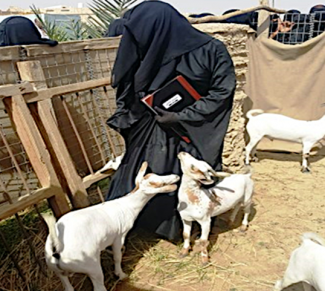Of Women Livestock Keepers in Yemen
“I expect that the new skills and experience I have gained … will help me provide better food for my family, ensure that my children complete their education, and improve and grow my business.”
— Ms. Jameelah Mahfoodh Bash’hab, Livestock Keeper, Hadramawt Governorate
In a livestock market in Sayo’un District, 10 goats dash around a dusty pen. Bleating energetically, the animals nuzzle with affection against the dark folds of their mistress’s balto —the long, loose flowing black garment that Yemeni women wear when they go out in public. Their keeper, Jameelah Mahfoodh Bash’hab, shows off her goats with pride. Thanks to the intensive feeding regimen and improved animal husbandry practices she learned with support from USAID, Mrs. Bash’hab’s goats are plump and healthy, bringing her faster and better returns than ever before. Results are enabling her to secure an improved livelihood for her family and the money to invest in a growing goat-fattening business.
Livestock-keeping is women’s work in Yemen. Since only a tiny fraction of the country’s land (less than 3 percent) is suitable for growing crops, it is also an essential source of income and nutrition for rural households. Farmers rely on small ruminants, such as goats, because they are well adapted to Yemen’s dry and rocky conditions, able to get by on minimal water and grazing. The animals provide not only a source of milk and meat for farming families, but also act as a form of four-legged savings to be cashed in during times of need.
Mrs. Bash’hab is the sole breadwinner for her large family, as her husband’s heart condition prevents him from working. Although their two eldest daughters are married, four more children remain at home pursuing their studies. Livestock-keeping is Mrs. Bash’hab’s main source of income.
Prior to completing a training session through the USAID Economic Recovery and Livelihoods Program (ERLP), Mrs. Bash’hab used traditional methods to raise her animals. She would feed them a maintenance diet for 12 months or so, until they reached a weight of about 20 kilograms, when she would take them to market to be sold. Mrs. Bash’hab did not provide the goats with any supplemental nutrition or preventative health treatments, occasionally losing some to disease or other conditions.
Following the training course, Mrs. Bash’hab purchased 10 three-month-old goats and put them on the intensive feeding regimen demonstrated by the program, using locally available fodder. She also had her animals dipped and vaccinated to protect them from common parasites and diseases, such as peste des petits ruminants, which is rampant and potentially fatal.
The results initially took Mrs. Bash’hab by surprise. “In just three months, my goats had gained as much weight as they did in six months using our traditional feeding practices,” she explains.
The animals presented a consistently healthy weight, condition, and appearance, making the whole herd more appealing and valuable. Moreover, because they were younger and more tender than goats fed using traditional methods, Ms. Bash’hab’s animals were in high demand. As a result, she was able to sell them for double the amount she could charge previously.
Discounting the costs of buying and caring for her goats, Mrs. Bash’hab calculated that she made a profit of 40 percent off her first group of 10 goats. With her earnings, Mrs. Bash’hab was able to pay off her outstanding debts, provide for her family, and expand her goat-fattening business. Moving forward, she anticipates increasing her annual income several times over thanks to the multiplier effect of being able to produce higher value animals in half the time as before.
“I expect that the new skills and experience I have gained from this training will help me provide better food for my family, ensure that my children complete their education, and improve and grow my business,” says Mrs. Bash’hab.
USAID prioritizes outreach to rural women, tapping into the widespread unmet demand for opportunities to advance their activities and benefit their livelihoods. USAID, through ERLP’s targeted interventions, ensures that gender equity promotion not only contributes to but actually serves as a key driver of economic recovery—within individual households and across Yemen more broadly.
USAID’s Economic Recovery and Livelihoods Program (ERLP), addresses critical economic stabilization challenges in Yemen. At the macroeconomic level, it restores economic stability, enhances fiscal management, and increases international trade flows. At the microeconomic level, ERLP helps small producers create their own businesses, strengthens private sector performance and competitiveness, and creates jobs and new market linkages for sustainable livelihoods.

Photo: ERLP
